Mayfair Pumping Station, Part 1
Little-known, but hardly nondescript, the northwest neighborhood of Mayfair is an architecturally simple place. While it has much to recommend for it as the buckle—or, more accurately, a large stud—on Chicago’s Bungalow Belt, the local buildings are mostly pleasant emissaries of their respective eras. Not historically important or particularly stunning, but pretty or impressive in their own way.
Such is the case with the Mayfair Pumping Station (4850 W. Wilson Avenue). What might have been a bland stack of utilitarian bricks and glass was instead transformed into a pleasant, visually stimulating interplay of quadrangles. I don’t know what you call this style of architecture, but it manages to seem both old world and bold young Chicago at the same time. A building with the simple function of pumping water to its surrounding community, its history and the man who presumably designed it, are somewhat more interesting and complex.
*****
The northwest side was powerful thirsty, but Mayfair and the surrounding villages were a good stretch away from Lake Michigan’s shores. The Lakeview pumping station three miles south kept the water flowing, but water pressure was pathetic—likely a worse situation in those pre-deodorant days. A letter from Mrs. Q.D. Peake to the September 3, 1913 Chicago Daily Tribune’s “The Friend of the People” column bespoke a parched population.
“For the last three days… the water in the bathroom just trickles from the faucets, and the toilet bowl cannot be flushed at all, necessitating the carrying of water up from the first floor…We must have water! What will the water department do about it?”
City Engineer John Ericson assured Mrs. Peake that three new engines had been recently installed at the Lakeview station, bringing some oomph to the pressure. More importantly, Mayfair would get its own station in the next few years. Patience was necessary though, since they’d only just started digging an eight-mile-long connecting tunnel to the Wilson Avenue intake crib, located three miles offshore in Lake Michigan. The actual pumping station wouldn’t be completed for a few more years.
Built on the former farmland of Elsie Budlong, Chicago pickle factory owner, the station’s construction was an imposing task. Per the January/June 1915 issue of the professional journal The Iron Age, Chicago City Architect Charles Kallal submitted plans for the station’s engine and boiler room. Shortly thereafter—according to the December 31, 1915 Annual Report from the Department of Public Works—56,000 yards of earth needed to be removed from the site by good old-fashioned steam shovels. (Note the below photos, taken from John Thomas Lucas’ civil engineering thesis, “Construction of Substructure of Mayfair Pumping Station, City of Chicago (1917)”.
Naturally, this was Chicago. The station faced the usual construction delays, graft, and false starts:
- On November 22, 1915, the Trib reported the suspension of three city inspectors over delivery of inferior short leaf, “lob lolly” pine to be used in the station’s construction. More than 700,000 feet of lumber had already been delivered.
- In a June 1916 article topped with the headline “Waste on Northwest Side Threatens Water Famine” (why “famine” rather than “drought,” I’m not sure), Commissioner of Public Works W.R. Moorhouse admonished Mayfairians to stop leaving their faucets and lawn sprinklers running. They were sapping the folks in westerly Austin,IL, and the rest of the northwest side of water pressure.
- Two years later, on February 21, 1918, “The Friend of the People” ran a letter from “J.L.”, asking when pressure would improve. John Ericson spoke up again, telling J.L. to, as it were, hold his or her water. Strikes and a minor thing called World War I had slowed down construction.
- In a staggering example of how different the times were from our own, the Journal of the American Medical Association (Vol. 17, 1918) reported that the opening of the Wilson Avenue tunnel and pumping station were once more delayed when it was discovered a worker had typhoid. This may be what delayed opening day July 1, 1918, as reported by the Trib. I suspect they were assiduously avoiding any mention of the deadly disease.
- A week later, the Trib promised a delay of only four or five more days, but as of July 14, the station had yet to open. This time “M.K.” wrote to “The Friend of the People,” asking when the police station being constructed at Chicago and Racine (long since demolished, likely during the building of the Dan Ryan Expressway) would be completed. Not until the pumping station in Mayfair was finished, was the Trib‘s reply, and only after city officials determined “…if adequate water pressure can be secured.”
- Come August 7, the station finally opened its pipes and fired up its engines (a group of horses standing at the ready to keep the pumps moving if the engines failed). But it was an inglorious debut. Flushing out the Wilson tunnel and Mayfair pumps brought only muddy, nonpotable water to the folks in Mayfair, North Austin, Irving Park, Jefferson Park, and West Ravenswood.
At last (and according to the cool, clear, somewhat pure Lake Michigan water issuing from my home’s faucets), the station was completed by 1919. Thus far, I lack any period photographs to be sure, but it appears relatively intact. Surely, there are elements of modernization, but, as a friend pointed out, the large front windows and nifty globe lamps out front appear unmolested.
The fact that the building is protected by the government, with attendant signage outside declaring same, have probably kept it unmarred by taggers and salvagers despite its relatively out-of-sight location (it sits beside the Union Pacific/Northwest rail line, and is best reached by driving through the Wilson Avenue tunnel at Cicero). The smokestack, if I’m reading right, is not original, nor in use, since, I’m guessing, the machinery is no longer coal-powered. The previous stack was dismantled in 1958, essentially turned inside out as the workers started at the top, dislodging and heaving bricks into the stack for collection below. It’s unclear when the current smokestack was erected, or if the old one was restored.
Next, Chicago City Architect Charles W. Kallal, Floods, Attempted Murder… and Fish!
One Response to “Mayfair Pumping Station, Part 1”
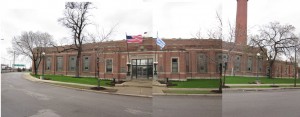
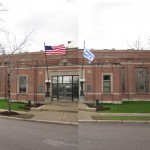
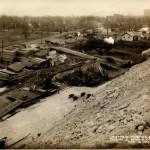
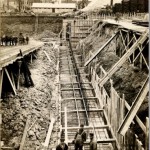


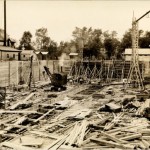
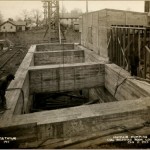

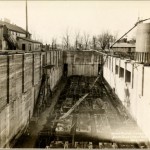
Those are some great old photos. Nice find!